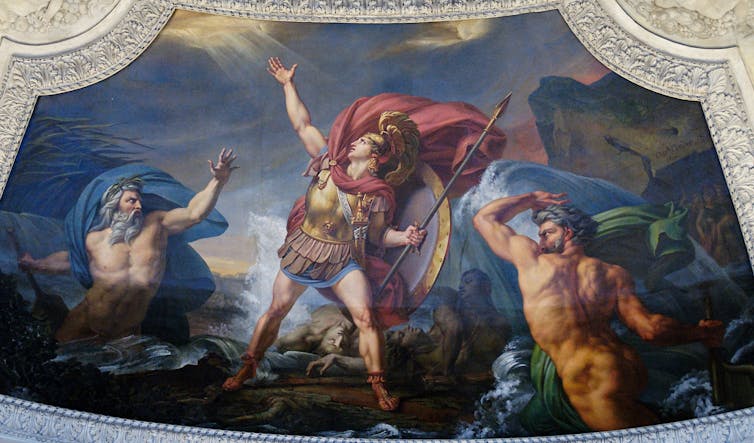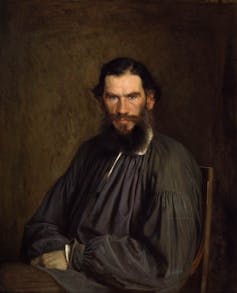Homer’s Iliad is so canonical in world literature that even with out having learn the epic, most individuals are acquainted with the broad state of affairs of the Trojan battle, triggered by the Trojan prince Paris’s abduction of the Greek magnificence Helen, “the face that launched a thousand ships”.
Nonetheless, the Iliad is hardly a romance. The kidnapping scene is simply alluded to within the poem. The key theme is battle, with the battle approaching its tenth yr.
The Iliad is a poem of violence, with lots of the scores of deaths described in excruciating element. However the struggle shouldn’t be solely towards the human foe. There may be additionally the battle to guard nature, as Homeric heroes tackle the function of eco-warriors in a bodily setting threatened by human exercise.
There may be an acute consciousness of the pure world within the Iliad, of its flux and fragility. Certainly, a major barrier to identifying Homer’s Troy with the stays of the traditional metropolis of Troy positioned in trendy northwestern Turkey is the truth that the panorama has modified a lot over the three millennia because the historic occasion the Iliad is, arguably, primarily based on.
In fact, battle means huge destruction to the setting, as illustrated by the deep trench the Greeks dig to defend their ships – an encroachment which provokes the gods. There may be additionally unnatural disasters to deal with, resembling strikes from Zeus’ thunderbolts.
The precise battle is described as each flood and wildfire. On this context, Homeric heroes should get nature on their facet if they’re to beat the enemy.
As Homer not often feedback immediately on the narrative, similes (literary gadgets that present similarity between totally different individuals or issues) typically do the work of depicting the environmental forces. Particularly, similes involving the weather are extra frequent than meteorological phenomena truly skilled by the characters.
In one scene in regards to the ferocity of his assault, chief Trojan hero Hector is in comparison with a wave smashing right into a floundering ship and a lion pouncing on cattle.
This twin picture, combining the inanimate (the wave) and animate (the lion) worlds represents the revenge of warrior and nature. Revenge is a recurring motif within the Iliad as a response to an affront. Nonetheless, Hector’s revenge on the Greek invaders is compromised as a result of it’s preordained that he can be killed and Troy taken. Nature’s revenge is justified by the human devastation of the setting.
The lion is a frequent simile in Homer and significantly apt as a result of the European lion inhabitants had been ravaged during the classical period. So Hector’s revenge is extra full when he’s considered by means of this imagery as an instrument of nature, contrasting human mortality with the boundlessness of the pure world.
ACHILLES’ BATTLE AGAINST THE RIVER
In an extraordinary episode that includes the Iliad’s central hero Achilles, Homer makes use of direct narrative to place the eco-warrior.
For a lot of the Iliad, Achilles is successfully on strike, peeved by the confiscation of his enslaved woman, Briseis. When he does return to motion, he too is motivated by revenge as a result of Hector has killed his good friend Patroclus.
Achilles carries the onslaught into the river Scamander, which turns into glutted with corpses. The Scamander can be a god and objects to the violation, however Achilles continues in his frenzy.
Emily Wilson, writer of an acclaimed recent translation of the Iliad, reads this as “a human fighting the landscape”. But, by bringing the slaughter to the river, Achilles is showcasing the affect of the battle on the setting and nature’s final superiority.

The mortal enemy can’t cease Achilles, however Scamander swamps him and he needs to be bailed out by allied gods. Nearly drowned by the indignant river, a bedraggled Achilles trudges by means of fields disfigured by corpses and discarded armour, and recognises that the forces of nature are inviolable so ought to stay unviolated.
Spanning days slightly than years, the drama of the Iliad is however a snapshot of the Trojan battle. But, this very transience suggests the character of the battle – the battle with nature.
To be a hero means to seek out kleos (fame), which is prized as a result of it transcends the oblivion of time. Human life can’t be renewed, so it ought to be valued. This finiteness applies even to the seemingly limitless assets of nature.
Homeric eco-warriors will not be represented as taking environmental action within the trendy sense – there was no environmental discourse in Greek. As a substitute, the narrative displays their precarious place in a fragile pure world. For heroes to outlive, nature should thrive.
BEYOND THE CANON
As a part of the Rethinking the Classics collection, we’re asking our specialists to advocate a ebook or paintings that tackles comparable themes to the canonical work in query, however is not (but) thought-about a basic itself. Right here is Wayne Mark Rimmer’s suggestion:
Much less celebrated than Battle and Peace is Leo Tolstoy’s novel Resurrection (1899), the story of aristocrat Nekhlyudov’s social-political reawakening.

Written six years earlier than the primary Russian revolution, Resurrection carries a robust evangelical message. It is usually a commentary on the setting, particularly, how social class modifications perceptions in the direction of the land.
The peasants of their poverty have a realistic angle, evaluating land by way of yield and exploitation, as illustrated by a husband jailed for illicit logging. In distinction, Nekhlyudov has a robust appreciation of the land’s bodily magnificence and a way of affinity that comes by means of possession.
Nekhlyudov’s give up of his land to the peasants meets with their incredulity, as does his assertion: “The earth is not any man’s.” Left unanswered is how the peasants understand the land as its masters. Tolstoy, a land proprietor himself, lived neither to see the 1917 Russian revolution nor Stalin’s collectivisation programme, which desolated the countryside.![]()
(Writer: Wayne Mark Rimmer, Lecturer in English for Educational Functions, University of Manchester)
(Disclosure Assertion: Wayne Mark Rimmer doesn’t work for, seek the advice of, personal shares in or obtain funding from any firm or organisation that might profit from this text, and has disclosed no related affiliations past their tutorial appointment)
This text is republished from The Conversation beneath a Inventive Commons license. Learn the original article.
